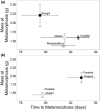Can predators stabilize host-parasite interactions? Changes in aquatic predator identity alter amphibian responses and parasite abundance across life stages
- PMID: 36407903
- PMCID: PMC9666717
- DOI: 10.1002/ece3.9512
Can predators stabilize host-parasite interactions? Changes in aquatic predator identity alter amphibian responses and parasite abundance across life stages
Abstract
The role of parasites can change depending on the food web community. Predators, for instance, can amplify or dilute parasite effects on their hosts. Likewise, exposure to parasites or predators at one life stage can have long-term consequences on individual performance and survival, which can influence population and disease dynamics. To understand how predators affect amphibian parasite infections across life stages, we manipulated exposure of northern leopard frog (Rana pipiens) tadpoles to three predators (crayfish [Orconectes rusticus], bluegill [Lepomis macrochirus], or mosquitofish [Gambusia affinis]) and to trematode parasites (Echinostoma spp.) in mesocosms and followed juveniles in outdoor terrestrial enclosures through overwintering. Parasites and predators both had strong impacts on metamorphosis with bluegill and parasites individually reducing metamorph survival. However, when fish were present, the negative effects of parasites on survival was not apparent, likely because fish altered community composition via increased algal food resources. Bluegill also reduced snail abundance, which could explain reduced abundance of parasites in surviving metamorphs. Bluegill and parasite exposure increased mass at metamorphosis, which increased metamorph jumping, swimming, and feeding performance, suggesting that larger frogs would experience better terrestrial survival. Effects on size at metamorphosis persisted in the terrestrial environment but did not influence overwintering survival. Based on our results, we constructed stage-structured population models to evaluate the lethal and sublethal effects of bluegill and parasites on population dynamics. Our models suggested that positive effects of bluegill and parasites on body size may have greater effects on population growth than the direct effects of mortality. This study illustrates how predators can alter the outcome of parasitic infections and highlights the need for long-term experiments that investigate how changes in host-parasite systems alter population dynamics. We show that some predators reduce parasite effects and have indirect positive effects on surviving individuals potentially increasing host population persistence.
Keywords: anurans; carryover effects; host–parasite interactions; predator–prey interactions; trematodes.
© 2022 The Authors. Ecology and Evolution published by John Wiley & Sons Ltd.
Conflict of interest statement
Authors have no conflict of interest to declare.
Figures









Similar articles
-
The combined influence of trematode parasites and predatory salamanders on wood frog (Rana sylvatica) tadpoles.Oecologia. 2011 Aug;166(4):1077-86. doi: 10.1007/s00442-011-1946-8. Epub 2011 Mar 8. Oecologia. 2011. PMID: 21384178
-
Parasites alter freshwater communities in mesocosms by modifying invasive crayfish behavior.Ecology. 2016 Jun;97(6):1497-506. doi: 10.1890/15-1634.1. Ecology. 2016. PMID: 27459780
-
Parasite predators exhibit a rapid numerical response to increased parasite abundance and reduce transmission to hosts.Ecol Evol. 2013 Nov;3(13):4427-38. doi: 10.1002/ece3.634. Epub 2013 Oct 10. Ecol Evol. 2013. PMID: 24340184 Free PMC article.
-
Mechanisms by which predators mediate host-parasite interactions in aquatic systems.Trends Parasitol. 2021 Oct;37(10):890-906. doi: 10.1016/j.pt.2021.06.006. Epub 2021 Jul 16. Trends Parasitol. 2021. PMID: 34281798 Review.
-
The ecology of fish parasites with particular reference to helminth parasites and their salmonid fish hosts in Welsh rivers: a review of some of the central questions.Adv Parasitol. 2002;52:1-154. doi: 10.1016/s0065-308x(02)52011-x. Adv Parasitol. 2002. PMID: 12521260 Review.
References
-
- Ade, C. M. , Boone, M. D. , & Puglis, H. J. (2010). Effects of an insecticide and potential predators on green frogs and northern cricket frogs. Journal of Herpetology, 44, 591–600.
-
- Beldomenico, P. M. , & Begon, M. (2010). Disease spread, susceptibility and infection intensity: Vicious circles? Trends in Ecology & Evolution, 25, 21–27. - PubMed
-
- Bertram, C. R. , Pinkowski, M. , Hall, S. R. , Duffy, M. A. , & Cáceres, C. E. (2013). Trait‐mediated indirect effects, predators, and disease: Test of a size‐based model. Oecologia, 173, 1023–1032. - PubMed
-
- Berven, K. A. (1990). Factors affecting population fluctuations in larval and adult stages of the wood frog (Rana sylvatica). Ecology, 71, 1599–1608.
-
- Biek, R. , Funk, W. C. , Maxell, B. A. , & Mills, L. S. (2002). What is missing in amphibian decline research: Insights from ecological sensitivity analysis. Conservation Biology, 16, 728–734.
Associated data
LinkOut - more resources
Full Text Sources
Research Materials
Miscellaneous

